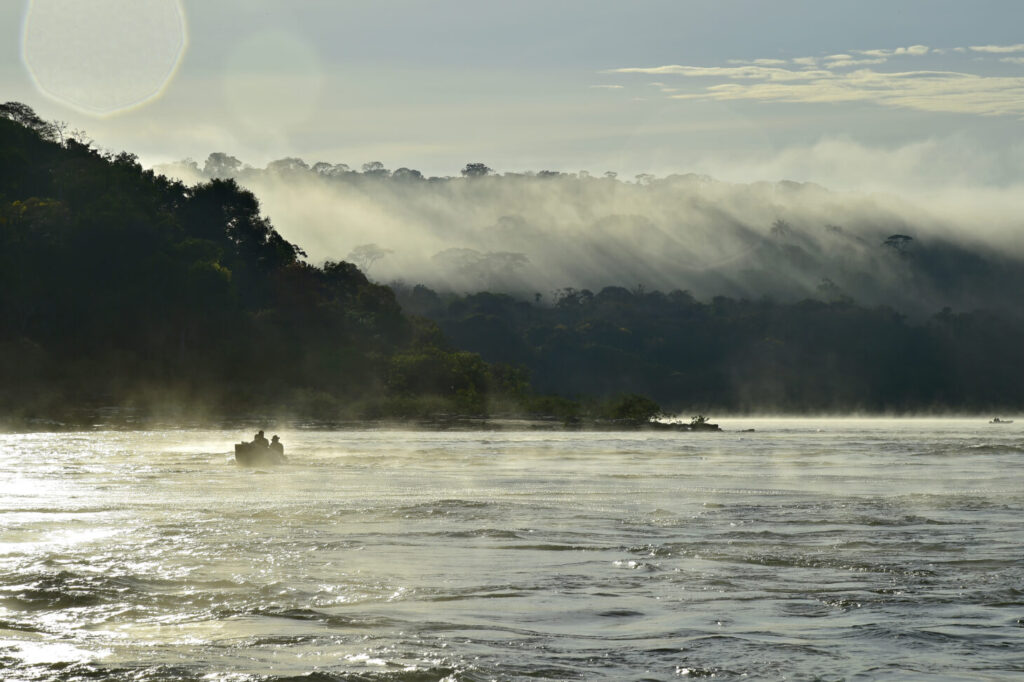Sustainable economies strengthened Apiaká people during recovery of the territory
Chestnut collection and sport fishing generate income at Ti Apiaká do Pontal and Isolados
By Túlio Paniago/OPAN

After more than 25 years of fighting, the Apiaká people finally had the recognition of their land by the Brazilian State. This achievement and the End of licensing of the Castanheira Hydroelectric Power Plant, which jeopardized all the sociobiodiversity of the Juruena River basin, were celebrated in the 11th edition of the Juruena Vivo Festival, held between the 8th and 10th of November at Aldeia Curva, Indigenous Land (Ti) Erikpatsa), of the Rikbaktsa people.
During one of the tables of the event, entitled “Regional Economy that Values the Forest and the Standing Cerrado”, representatives of indigenous peoples and traditional communities exchanged experiences based on their respective practices with different value chains of sociobiodiversity. It was on this occasion that Eduardo Morimã, of the Apiaká people, detailed how the management of Brazil nuts and community-based tourism were important to ensure the community’s well-being during the process of retaking the territory.
In addition to sustainable income generation, the activities contributed directly to territorial management. After all, they favored that the people could remain in the territory, also helping to prevent the advancement of pressures and threats that could cause a series of socio-environmental damages.

“When we reoccupied our traditional land, we had a very close mining, about 15 minutes by boat. And we realized that if we didn’t have a source of income to give economic sustainability to families within the territory, maybe some indigenous people would end up looking for service in the mining”, recalled Eduardo.
Given this context, the Apiaká organized themselves to structure the management of chestnuts and community-based tourism based on sport fishing. “We work from March to November in tourism. This is where the chestnut period comes in, which goes from December to the beginning of the other season.[de pesca]”, explained Eduardo.
In addition to adjusting the natural agendas of the two activities, they also had to reconcile them to the local calendar itself. “We also couldn’t give up our fields, our culture and customs, everything is involved. So, when it comes to the countryside, we take turns. Those who have been in tourism for the longest time, come to do the swidden. And those who were in the village, and who have already built their fields, go there to work in the place of those who came”, detailed Eduardo.
The Apiaká are finalizing the letter of consent requesting authorization from the National Foundation for Indigenous Peoples (FUNAI) for the practice of community-based tourism at TI Apiaká do Pontal and Isolados. But they have been legally working with fishing tourism for three years, after all they are the protagonists of a research with biodegradable sinkers (based on clay and sand), an ecological alternative to the traditional lead, which are proven to be toxic. “We did the ecological sinker experiment and it has worked very well. It gave visibility to the project and made it possible for us to be able to work”, reported Eduardo.
Finally, about the benefits of tourism and chestnut management, he highlighted the involvement of the community, environmental protection, income generation for families and the strengthening of their organizations. The implementation of community-based tourism and the strengthening of the nut production chain are axes of the cradle of the waters, a project carried out by Operation Native Amazon (OPAN) with the Apiaká and Rikbaktsa peoples, sponsored by the Petrobras Program. socio-environmental. The birthplace of the waters also supported the realization of this and other editions of the Juruena Vivo Festival.

Regional economies that value the forest and cerrado standing
In addition to Eduardo Morimã, other people shared their experiences during the table “regional savings that value the forest and cerrado standing”. Taking advantage of the tourism hook, Ana Vylena Souza, from Rede Tucum (CE), spoke about the successful experience of community-based tourism in extractive communities in Ceará.
Tatá Apurinã, Vice-President of the Association of Indigenous Producers of the Indigenous Land Caititu (APITC), of Amazonas, gave details about the agroforestry system and on the role of the association in this work. Jomilson da Silva Andrade, also from TI Caititu, explained about the management of Amazonian chestnuts and how the structuring of the activity has contributed to the quality of life of the Apurinã people.
Aldenor Matsimu, president of one of the Rikbaktsa people’s associations, presented the history of family farming at TI Japuíra and its importance to the people. He highlighted the project they are currently working on, which provides for the sustainable production of various foods in one hundred hectares of the territory, each family will be responsible for one hectare.
Elaine Guilherme, president of the São Brás de Nova Bandeirantes Association, also reported her experience in family farming. The group of black cherry women, of which it is a part, produces special coffees with sustainable practices. She detailed the organization and structuring of the activity, which today is the main source of income generation for her community.
The table Eduardo Darvin, from the Instituto Centro de Vida (ICV), and Renato Pereira da Silva, from the Pact das Águas, also composed the table, who presented details on sustainable income generation projects that their organizations have supported with indigenous peoples and traditional communities.
